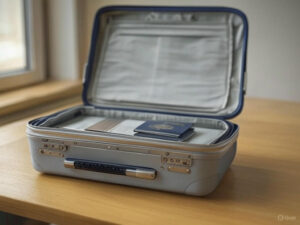Introduction
In recent years, the importance of maintaining sanitation while traveling has gained prominence, especially in the context of global health crises. As nations grapple with various infectious diseases, travelers are increasingly concerned about their health and hygiene during their journeys. Whether on a plane, in a hotel, or exploring local attractions, the need for effective sanitation measures has never been more pertinent.
Traveling exposes individuals to a variety of environments, each with its own potential hygiene challenges. Shared spaces, such as airports and public transport, often serve as hotspots for germs, leading to heightened anxiety among travelers about their safety. Common concerns include the cleanliness of public restrooms, the risk of encountering contagious illnesses, and the effectiveness of personal hygiene practices while on the go. Consequently, travelers are seeking reliable solutions to ensure their health is not compromised during their adventures.
This blog post aims to equip readers with knowledge about essential sanitation gear that can make a significant difference in their hygiene practices while traveling. From portable hand sanitizers to disinfectant wipes, we will explore a variety of products that are both practical and convenient for travel. These items can be easily packed in luggage or carried in a daypack, allowing for quick access when needed. By understanding the significance of these sanitation tools, travelers will be better prepared to minimize health risks and enjoy a safer journey.
As we delve into the specifics of sanitation gear to pack, readers will learn not only about the products themselves but also about best practices for their use. The ultimate goal is to empower travelers to prioritize their well-being, enabling them to focus on the experiences their journey offers without compromising on hygiene.
Why Sanitation Matters While Traveling
Traveling has become an integral part of our lives, offering opportunities for exploration, cultural exchange, and recreation. However, it is essential to be cognizant of the health risks associated with travel, particularly the potential for exposure to various germs and viruses. Recent studies have revealed that travelers are significantly susceptible to pathogens that thrive in crowded environments such as airports, hotels, and other public spaces. These pathogens can lead to illnesses ranging from minor gastrointestinal disturbances to more severe infections.
According to the World Health Organization, approximately 1 in 4 travelers experience travel-related illness, with respiratory infections and gastrointestinal diseases being the most common ailments. The risks are amplified by the intimate proximity travelers often share in planes and public transport. Moreover, research indicates that inadequate sanitation practices can directly contribute to the outbreak of infectious diseases, making proper hygiene a critical aspect of safe travel.
Moreover, recent global events have underscored the importance of maintaining stringent sanitation protocols while on the move. The COVID-19 pandemic demonstrated how quickly viruses can spread in uncontrolled environments, leading to widespread health crises. Personal hygiene measures, such as frequent handwashing and the use of sanitizers, have proven effective in minimizing risks. However, these basic practices must be complemented by the smart use of sanitation gear, which can provide an additional layer of protection against unseen threats.
In light of these statistics and findings, it is clear that traveling without implementing rigorous sanitation measures can lead to a myriad of health issues. From the onset of common cold symptoms to the more severe consequences of viral infections, maintaining hygiene during travel is paramount. By prioritizing sanitation, travelers can not only safeguard their health but also enhance their overall travel experience.
Essential Sanitation Gear: A Comprehensive List
Traveling can expose individuals to various germs and bacteria, making it essential to prioritize hygiene during journeys. Below is a comprehensive list of essential sanitation gear that every traveler should consider bringing along to help maintain cleanliness and ensure a safe travel experience.
Hand Sanitizer: Hand sanitizer is highly effective in killing germs when soap and water are not readily available. Opt for a sanitizer that contains at least 60% alcohol content. This portable solution allows travelers to quickly disinfect their hands after touching surfaces in public areas, such as airports and restrooms.
Disinfectant Wipes: These versatile wipes can be used to disinfect surfaces such as airplane trays, hotel room doorknobs, and rental car interiors. Disinfectant wipes help eliminate viruses and bacteria, providing peace of mind while traveling. It is advisable to choose wipes that are EPA-approved for efficacy against illness-causing germs.
Face Masks: Wearing a face mask in crowded places is an important sanitation measure, especially in light of respiratory illnesses. Select masks that fit snugly and consist of multiple layers for optimal protection. Not only do masks help prevent the spread of infections, but they also serve as a barrier against dust and pollutants in the environment.
Portable Soap: While hand sanitizer is convenient, nothing beats washing hands with soap and water. Portable soap options, such as soap sheets or solid bars, are lightweight and easy to pack. Proper handwashing, especially before meals, greatly reduces the risk of gastrointestinal illnesses during travels.
Bringing along these essential sanitation gear items can significantly enhance hygiene practices while traveling. Incorporating hand sanitizer, disinfectant wipes, face masks, and portable soap into your travel essentials will ensure that you are better equipped to manage cleanliness and protect your health during your journeys.
Choosing the Right Products: A Guide
When embarking on your travel journey, prioritizing sanitary practices is essential to ensure your health and wellbeing. Selecting the right sanitation products can greatly influence your experience, and understanding what to look for during your selection process is crucial. Begin by evaluating the ingredients of the products. Opt for sanitation gear that utilizes natural and non-toxic components, as these tend to be more gentle on the skin while effectively eliminating germs and bacteria.
Effectiveness is another key factor. Read reviews and look for products that have been clinically tested or endorsed by health professionals. A reputable sanitation product should clearly state its efficacy against common pathogens and provide detailed instructions for use. Look for certifications or seals from recognized organizations, which can be indicators of quality.
Packaging also plays a significant role in product efficacy and ease of use. Choose conveniently packaged items, such as travel-sized sanitizers or wipes that are easy to carry. Airtight containers that prevent spillage and maintain the integrity of active ingredients can further enhance your travel experience. Eco-friendliness is becoming increasingly paramount; products that are biodegradable or come in recyclable packaging can help minimize your carbon footprint while maintaining hygiene standards.
Several trusted brands have consistently received high marks for their sanitation products. For instance, brands like Purell and Mrs. Meyer’s Clean Day offer selections of hand sanitizers and cleaning wipes that are both effective and widely endorsed. Another excellent option is Seventh Generation, known for its commitment to eco-conscious ingredients and packaging. Additionally, Dr. Bronner’s offers organic hand sanitizer in various sizes, suitable for both travel and home use. By considering these factors, you can confidently choose sanitation products that align with your travel needs and preferences, ensuring a clean and safe journey.
Packing Tips for Sanitation Gear
Packing sanitation gear for travel requires meticulous planning to ensure that essential items are readily accessible while maximizing the available luggage space. One effective strategy is to use packing cubes or pouches, which allow travelers to compartmentalize sanitation supplies distinctly from clothing and other items. By designating a specific cube for sanitation gear, travelers can quickly locate their hygiene essentials without rummaging through their bags. It is advisable to choose transparent packing cubes; this not only aids in visibility but also allows for quick access during security checks.
Travelers should consider the weight and bulk of sanitation items when selecting what to bring. Lightweight options are preferable. For instance, opt for a compact, collapsible hand sanitizer bottle instead of a large one. Likewise, using travel-sized toiletries can save space and meet the regulations for liquids in carry-on luggage. Another efficient method is to utilize multi-purpose items such as antibacterial wipes, which can serve as both cleaning agents and hand sanitizers.
Organization is key when it comes to packing sanitation gear. Group items by type—for example, all sanitization supplies in one pouch, masks in another, and personal care products in a separate organizer. This ensures that not only are items stored efficiently, but they also remain orderly throughout the journey. Additionally, consider packing frequently used items, like hand sanitizers and wet wipes, in external or easily accessible pockets of the bag. This provides convenience during travel when quick access is required.
Lastly, think ahead about the usage environment. If traveling to locations with limited access to sanitation facilities, plan accordingly by packing extra supplies. With these packing tips, travelers can efficiently include their sanitation gear while ensuring their travels remain hygienic and organized.
Real-Life Scenarios: When Sanitation Gear Makes a Difference
Traveling can expose individuals to various hygiene challenges, especially in regions with inadequate sanitation facilities. Several travelers have shared their experiences highlighting how effective sanitation gear has proven essential at pivotal moments.
One traveler, Sarah, recounted her journey to Southeast Asia, where she encountered extreme humidity and limited access to clean water. While venturing through a village, she faced a situation where a public restroom lacked basic sanitary provisions. Equipped with her portable toilet seat cover and disinfectant wipes, she was able to minimize her exposure to germs. Sarah noted, “Having those supplies made all the difference. I felt like I could navigate difficult situations with confidence, knowing I had protection against germs.” This experience underscores the significance of carrying sanitation gear, particularly when sanitation practices are not universally observed.
In another instance, Mark, an adventurous backpacker, shared how his sanitizing gel and surface wipes became a lifeline during a long-distance bus ride through a remote area. The cramped quarters and lack of hygiene facilities raised concerns about illnesses. Mark utilized his gear before eating and after using shared facilities, effectively reducing his risk of gastrointestinal issues. Reflecting on this, he stated, “I always carry sanitation gear now. It has become part of my essentials list because I realized that one bout of illness can ruin an entire trip.” His experience highlights the importance of foresight and preparedness when it comes to maintaining health while traveling.
Additionally, another traveler, Lisa, experienced a sudden illness during a hiking trip and relied on her water purification system to ensure the safety of her drinking water. She remarked, “I would have been in real trouble without my sanitation equipment. It gave me peace of mind that I wouldn’t fall ill from contaminated water.”
These real-life scenarios demonstrate the critical role of sanitation gear in maintaining health and preventing illness during travel. The right equipment not only fosters confidence but also ensures an enjoyable and healthy travel experience.
Common Myths About Travel Hygiene
Travel hygiene is critical for maintaining health and well-being while on the go, yet many misconceptions persist regarding its importance and the effectiveness of various sanitation products. One prevalent myth suggests that basic handwashing is sufficient for keeping germs at bay. While washing hands with soap and water is indeed essential, studies show that the use of hand sanitizers with an alcohol content of at least 60% can significantly reduce the presence of pathogens when soap and water are not available. Thus, travelers are encouraged to carry portable hand sanitizers as a vital supplement to their hygiene routine.
Another common belief is that hotel rooms and public transport are inherently clean environments. In reality, numerous studies have indicated that surfaces in these locations can harbor various pathogens. Items such as remote controls, bed linens, and restaurant menus are often overlooked and can carry bacteria and viruses. As a precaution, travelers should consider bringing disposable sanitizing wipes to clean high-touch surfaces upon arrival at their accommodations or during their travels.
Additionally, people frequently underestimate the necessity of personal sanitation gear. Some travelers believe that items like portable toilets or travel-sized soap dispensers are unnecessary extravagances. However, these products can offer peace of mind, especially in areas where hygiene standards may be questionable. Carrying your own essentials can greatly enhance personal comfort and safety during trips. It is crucial to debunk the notion that travelers are overreacting by preparing adequately with sanitation gear; it is about prioritizing health rather than succumbing to fear.
In addressing these myths, we must recognize that understanding and practicing proper travel hygiene is not just about combating imagined fears but about making informed decisions. An evidence-based approach to travel sanitation can lead to healthier, more enjoyable travel experiences.
Staying Informed: Resources and Further Reading
To successfully navigate travel hygiene and sanitation practices, it is crucial for travelers to stay informed about the latest guidelines and information available from reputable sources. Several websites provide up-to-date information on public health best practices, specifically tailored for travelers. The Centers for Disease Control and Prevention (CDC) is one of the most reliable sources. Their website features a dedicated section on health information for travelers, covering a range of topics such as vaccination recommendations, disease outbreaks, and general safety tips that emphasize hygiene during travel.
Another valuable resource is the World Health Organization (WHO) website, which offers guidelines on global health issues, including sanitation practices that travelers should be aware of. The WHO provides extensive information on how to maintain health while traveling, emphasizing the importance of hygiene and preventive measures to avoid illness. It is advisable for travelers to familiarize themselves with WHO’s recommendations, particularly those relevant to their destination.
In addition to these organizations, the Travelers’ Health and Safety Handbook is an essential read for those committed to staying informed. This book provides in-depth insights into travel hygiene measures, with practical advice for maintaining cleanliness and reducing health risks while on the move. Articles such as “10 Essential Hygiene Practices for Travelers” can also be found in various travel health journals and magazines, highlighting everyday practices that can greatly enhance the travel experience.
By utilizing these resources and keeping updated on travel hygiene guidelines, individuals can significantly reduce their risk of illness and ensure a safer journey. The emphasis on sanitation practices is not only fundamental for personal well-being but also contributes to the health of fellow travelers and local communities. Therefore, staying informed is a powerful tool in the travel hygiene arsenal.
Conclusion
As travel enthusiasts, maintaining a high level of sanitation is essential to ensure not only our health but also the enjoyment of our journeys. Throughout this article, we have explored various types of must-have sanitation gear that can significantly enhance the travel experience. From portable hand sanitizers and disinfecting wipes to reusable water bottles equipped with filtration systems, these tools are not only practical but can also provide peace of mind while navigating different environments.
Additionally, the importance of hygiene extends beyond mere convenience; it plays a crucial role in preventing the spread of germs and viruses, especially in crowded places such as airports and bus stations. The integration of these sanitation products into our travel routines aids in fostering a safe environment for both ourselves and others. It is clear that being proactive about sanitation gear can lead to a more enjoyable and worry-free experience while on the road.
We invite you to reflect on your own sanitation practices while traveling. Have you tried any of the gear discussed in this post, or do you have additional recommendations? Sharing your experiences can provide valuable insights for fellow travelers looking to prioritize their health on the go. Please feel free to leave your thoughts in the comments section below.
If you found this article informative, consider sharing it on your social media platforms. Spreading the word about essential sanitation gear can help others travel more safely as well. Together, we can create a community focused on health and wellness while enjoying the adventures that travel has to offer.



